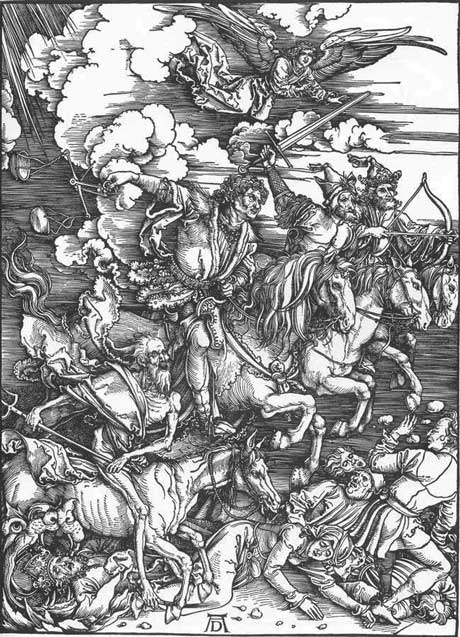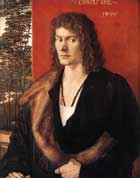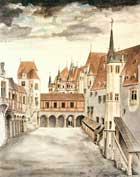The Four Horsemen of the Apocalypse - The Revelation of St. John: 4.
 |
|
|
"The Four Horsemen of the Apocalypse" is one of the most powerful creations in Albrecht Dürer’s art. It is rendering St. John’s vision after four of the seals have been opened.
Power was given to the superhuman, terrible horsemen, so that they can execute righteous vengeance on the earth. By looking at Dürer’s work, you can tell that nothing can resist their no-earthly might. They are unstoppable, they ride their horses “conquering, and to conquer,” and they have the power “to kill with sword, and with hunger, and with death, and with the beasts of the earth.”
Dürer faithfully adheres to the mystic record, and gives form and visible power to St. John’s vision story, without using his creative imagination. But the tremendous power the story communicates really stands out.
Three horsemen appear urged on by a mighty impulse to fulfil God's judgments on mankind, while the fourth, the Death, riding the pale horse, seems driven only by horrifying demoniac rage. Hell follows closely behind, in the form of a monster with wide-opened jaws, into which a crowned head is sinking. Even the horse betrays a feeling of devilish spite, in contrast with the somehow noble anger of the animal beside, ridden by the horseman who swings the balance aloft with his powerful outstretched arm.
This third mighty rider appears less calm than the other two on the right, but it is because he desires to swiftly execute the sentence against a wicked and perverse world, and not because he feels any exultation at human misery. The horseman with the bow, and the one with the sword as well, appear to have no other thought but the accomplishment of their terrible mission.
There are not too many figures in the composition, only eleven, out of which six represent the condemned human beings, trampled under the feet of Death’s horse. Less figures mean less mechanical woodcutting work, especially when compared with later woodcuts of the artist.
However, the cut is bold, and the genius of Dürer is revealed by each and every stroke, producing an overwhelming effect, using simpler elements than later works.
We may say that the effect of "The Four Horsemen of the Apocalypse" is more striking, more powerful than in other more elaborate compositions belonging to the cycle of Apocalypse. And the artistic genius which prevails against the mechanical work might very well indicate that this is one of the woodcuts Albrecht Dürer executed himself from start to finish.



